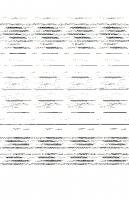On Thermal Emission and Evaporation from Water
385 72 926KB
English Pages 5 Year 1922
Recommend Papers
File loading please wait...
Citation preview
88
PHYSICS: M. ALLEN
PROC. N. A. S.
ON THERMAL EMISSION AND EVAPORA TION FROM WA TER By M. ALLEN DEPARTMENT OF PHYSICS, MOUNT HOLYOKx COLLEGI Read before the Academy November 16, 1922
A quantity which we may call the thermal emission from a water surface has been determined consisting of radiation, convection and conduction under the given conditions, comparable with the emissivity determined by Macfarlane' in 1871 for copper spheres, later verified and extended by Bottomley2'3'4 who varied the pressure of the air in the enclosure and the temperature of the enclosure, and at low pressures was able to verify Stefan's fourth power law. But one other attempt seems to have been ,made, that of Karl Siegel5 in his investigation of the heat emission of various stones; however, his work is based entirely upon a hypothetical law of Paschen's. In dealing with the problem of the thermal emission from water, the rate of evaporation has been found and studied as a function of the vapor pressures of water at the temperature of the hot water and of the surrounding envelope. The experiment is quite tedious as it must run for two or more hours in order that equilibrium be first obtained and then maintained for at least half an hour before any readings are taken. The rate of evaporation is determined by timing the loss in weight. The quantity of energy given up per second by unit area of water surface, per unit difference of temperature between the surface and surrounding bodies is the quantity which has been measured in this work; it is expressed in gram calories per second per square centimeter per degree Centigrade. This has been called by Preston' and Poynting and Thomson7 the emissivity of a surface. The energy loss in this case involved convection and conduction as well as radiation losses. The standard environment employed is a dry -black surface, but with this apparatus the black inner surface of the cone which performs this function is of necessity covered with a thin layer of the condensed water and is wet. In this experiment, the electrical input is expended in two ways,-in evaporating the water and in emission from the water surface. Knowing the rate of evaporation and using the values of the latent heat of evaporization of water, the amount of heat required per second for the evaporation is determined. From the remainder of the input, the thermal emission is then computed. There are several sources of error evident. Absolutely steady conditions of temperature and evaporation are perhaps never fully obtained although closely approximated. At the lower temperatures the evaporation rate can be duplicated very closely from day to day. At the higher temperatures, under apparently identical conditions, this rate varies
PHYSICS: M. ALLEN
VOL 10, 1924 -




![Water, Flood Management and Water Security Under a Changing Climate: Proceedings from the 7th International Conference on Water and Flood Management [1st ed.]
9783030477851, 9783030477868](https://ebin.pub/img/200x200/water-flood-management-and-water-security-under-a-changing-climate-proceedings-from-the-7th-international-conference-on-water-and-flood-management-1st-ed-9783030477851-9783030477868.jpg)


![Fuel From Water [Part 1]](https://ebin.pub/img/200x200/fuel-from-water-part-1.jpg)


